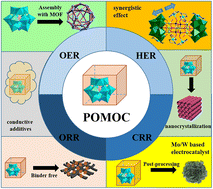Polyoxometalate-based metal–organic complexes and their derivatives as electrocatalysts for energy conversion in aqueous systems
Abstract
Global environmental deterioration and excessive fossil fuel consumption motivate researchers to explore green and sustainable power sources. It is promising to produce and utilize all kinds of clean energy by using electrocatalytic reactions including the hydrogen evolution reaction (HER), oxygen evolution reaction (OER), oxygen reduction reaction (ORR) and carbon dioxide reduction reaction (CRR). Suitable electrochemically active materials for working electrodes play a role in the catalytic effect. POM-based metal–organic complexes (POMOCs) exhibit advantages, such as a potential synergistic effect and high stability in aqueous systems, and can be used as energy-related electrocatalysts. In addition, POMOCs can further be taken as precursors for post-processing through appropriate approaches. Obtained Mo-, W-, and V-based composites can also be regarded as candidates for electrocatalysts. In this article, we classify and summarize the advantages and recent research progress on POMOCs and their derivatives as heterogeneous electrocatalysts in sustainable and clean energy conversion applications in aqueous systems. Besides, a brief overview of the reaction mechanism is also discussed.

- This article is part of the themed collection: 2022 Highlight article collection


 Please wait while we load your content...
Please wait while we load your content...